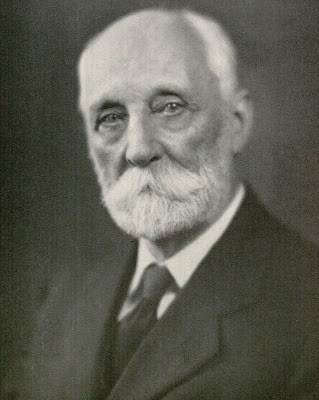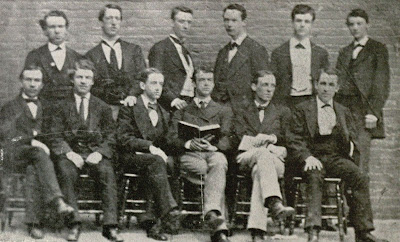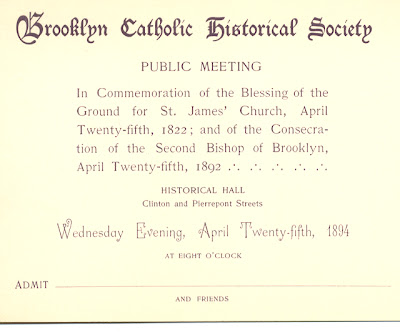On the evening of July 7, 1942, Thomas Francis Meehan passed away at his home on Greene Avenue in Brooklyn. He was 88 years old. It seems he was working on an article about Catholics in New York City, a topic to which he had devoted his life as journalist and historian, when he slumped over his desk peacefully around 9 p.m. In some ways, it almost seemed a fitting end for one dedicated to chronicling the history of Catholic Gotham, and passing it on to future generations. He died at his life’s work.
Few were better qualified to do that work. By the time of Meehan’s death, New York City had over four hundred Catholic churches, not to a mention a vast network of colleges and universities, schools, hospitals and childcare institutions. During his long life, he witnessed their birth and growth. And he liked nothing better than relating the story, either personally or on paper, of how they came to be.
He lived through the days when the Know-Nothings dominated national politics, through the Civil War and the building up of the nation and the Church. His father Patrick Meehan edited one of the city’s premier ethnic papers, The Irish American. Unlike many Irish New Yorkers, his childhood, writes his biographer, was marked by “culture, refinement, simplicity and a wealth of literary attainments.”
The oldest of eleven, Meean was born in Brooklyn and grew up in Jersey City. He studied at St. Francis Xavier College, a Jesuit school in Manhattan (now Xavier High School). In those days, the line between high school and college was not clearly demarcated. He graduated with a bachelor’s in 1873 and a master’s the following year. Several of his classmates went on to the priesthood, and three became bishops. But Meehan’s vocation lay elsewhere, in the field of writing.
The Class of St. Francis Xavier College, 1873. Meehan sits in the first row, fourth from the left. Last on the right in the back row is Charles E. McDonnell, who would become Bishop of Brooklyn in 1892.
After graduation, he went to work at his father’s newspaper. For thirty years, he was The Irish American’s managing editor. He also wrote for several other newspapers and was New York correspondent for several others. Most of what he covered was current events of interest to the city’s largely Catholic Irish community. But over time he became increasingly concerned with chronicling the city’s Catholic history.
After his marriage to Molly O’Rourke in 1881, Meehan moved to Brooklyn, where he spent the rest of his lives. Locally, in the 1890’s, he helped organize the short-lived Brooklyn Catholic Historical Society, which attempted to preserve items of interest to the local community. Nationally, he held leadership roles in organizations like the American Catholic Historical Association and the U.S. Catholic Historical Society.
One of the accomplishments of which Meehan was most proud was his work with the The Catholic Encyclopedia. It was Jesuit Father John J. Wynne, editor of The Messenger of the Sacred Heart, who came up with the idea at a time when encyclopedias were becoming all the rage. Wynne felt that their depictions of Catholicism veered toward the inaccurate and sometimes the unfair.
The Catholic Encyclopedia was to be “an international work or reference on the constitution, doctrine, discipline, and history of the Catholic Church.” It was an international operation, with nearly 1,500 contributors from 43 countries. Meehan was an assistant editor and wrote more articles than anyone else (over one hundred). Completed in 1914, one Protestant magazine called it the “greatest work undertaken for the advancement of Christian knowledge since the days of Trent.”
In 1909, Meehan joined the editorial staff of the new Jesuit magazine America, where his friend Father Wynne was editor. He worked there for 33 years, writing mainly historical articles. A Jesuit from America said of Meehan:
I always found that he was riding high on his enthusiasms, always discovering something he had not known before… always being reminded of something that was “awfully” interesting.
At home, Meehan led a comparatively quiet life, but sitting back in his chair in the back parlor of his Brooklyn home, with its high ceilings and tall windows, he came fully alive as he talked about the days when he met Archbishop John Hughes, and of Civil War-era New York.
At 85, he was still making the hour-long commute from his Brooklyn home to America House in Manhattan. He liked to call himself the oldest Jesuit in the New York Province. At the time of his death, one Jesuit called Meehan “an integral part of he history of America.” He was remembered as a “well full of tradition.” If he had one fault, his co-workers remembered, it was
a cultured and inspiring fault. He loved to converse. Sometimes, in the stress of busy days the editors were not partial to talk. But it was hard to resist Mr. Meehan, for he was a very fascinating talker.
New York and Brooklyn Catholic history were his favorite topics. He saw it as his vocation to pass down the story of the local Church to the next generation. At times, he got frustrated with what he considered a lack of suitable enthusiasm on the part of his younger colleagues. But he literally went to his death telling the story he loved. Every historian should be so fortunate.















